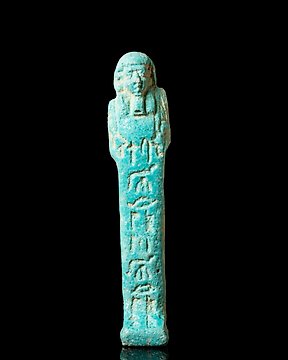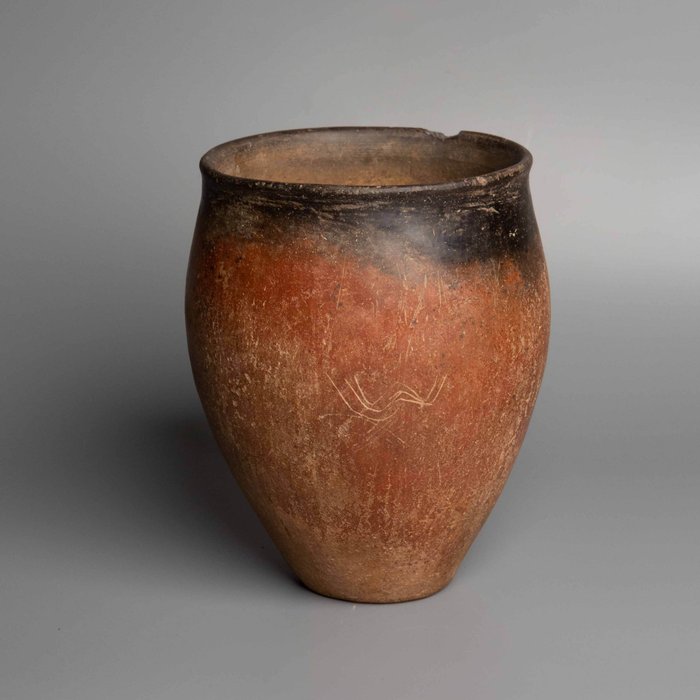
古埃及 彩陶烏沙布地與象形文字 (沒有保留價)
編號 82991991

編號 82991991

Black Top Vase with mark (water)
- very rare -
Ancient Egypt, Predynastic Period, Naqada I - II, 4000 - 3500 BC
MATERIAL: Pottery
DIMENSIONS: 19 cm Height.
PROVENANCE:
Private collection of Mr. Kobayashi, France, acquired on a trip to Egypt in the 1970s.
CONDITION: In good condition in general. Intact.
DESCRIPTION:
A pottery vessel belonging to the type known as “black-topped” as the upper area of the jar is black in colour. This example is quite a large jar for Predynastic productions. The body is ovoid, with a stable, but very small base to allow it to stand upright. The rim is slightly everted. It presents the mark of what could be the hieroglyph representing "water", and possibly a half figure of a fish can be seen underneath.
The red colour of the black-topped jars was achieved through the use of engobe. The exterior surface was covered with liquid clay mixed with water and red ochre (from earth with ferrous minerals) after the first drying and before the firing. The black was obtained when, after the firing, the vessel was placed head down in the embers. The carbonization of the part submerged produced the black colour.
More than 5000 years ago, around 3150 BC, Narmer, the king of Upper Egypt, conquered the area of the Nile Delta and united the fertile valley of the river into one kingdom, founding in this manner what would be one of the most splendid empire in antiquity, and becoming himself its first pharaoh. With this act, the Dynastic Period of Egyptian history began, which would last for more than 3000 years until the conquest of Egypt by Octavio and its assimilation as a Roman province.
But before the arrival of Narmer, and over a period of almost a millennium, the social, cultural and religious foundations of the future splendour of Egyptian civilization had already been laid in what is known as the Predynastic Period. This corresponds to the Chalcolithic, the Age of Copper, and must be considered to be divided into three stages. In Upper Egypt, the village of El-Badari became the nucleus of the groups known as the Badari culture (4400-3800 BC). The Amratian culture or Naqada I (4000–3500 BC) developed in parallel and then replaced the former. This was followed by the Gerzean or Naqada II (3500-3200 BC) and the Protodynastic or Naqada III (3200-3000 BC). Both the names Amratia and Gerzeh derive from sites where the oldest vestiges from these phases were found: El-Amrah, in Upper Egypt and el-Gerzeh, in Middle Egypt. The name Naqada, was given to these periods by Werner Kaiser, and was from the name of the city of Naqada, situated on the Banks of the Nile, 25 km north of Luxor.
This chronological division, in periods and cultures, derives from the study of the cultural material found in different burials, found both by Flinders Petrie, and later, by Kaiser. These burials had similar characteristics: a hole dug in the desert in which the deceased was buried in a foetal position. The dryness of the desert ensured the mummification of the body, thus conserving it for eternity. Grave goods were placed around the body, and these were principally: pieces of jewellery, vases in both terracotta and stone, cosmetic palettes, and knives and other flint tools. Although this was a formative period, objects of considerable artistic quality were made, and it was the moment of splendour for pottery vases, as well as for stone vases in a multitude of forms and typologies. One of these burial sites can be seen today in the British Museum.
Thanks to the volume and varied typology of pottery vases, Petrie established a classification of the types found at Naqada and called this Sequence Dating (SD). The result was a table with 50 SD numbers from 30 onward, so as to be able to incorporate ancient cultures and knives that were not known. The Badarian was established between SD 21-29; Naqada I between 30-38; Naqada II between 36-60 and Naqada III between SD 61-80. Later, Kaiser refined Petrie’s system, which is still valid today.
During the Naqada I Period tombs were individual or multiple, in the case of tombs of a woman and a child. The deceased were placed with the head towards the south, looking towards the west, and were placed with rush matting both above and below the corpse. The most ancient pottery pieces were shiny red recipients with black edges, known as “black-topped” pieces. These were mainly in the form of plates or ovoid vases with wide open mouths. In the Naqada II epoch the culture expanded to the north and the south. Black topped vases were still produced but the typologies became more varied and the forms refined. Moreover, two types of pottery have been documented: that made from coarse clay and that from a marly one. The latter exhibited geometric and decorative drawings in ochre over a cream under-colour. The predominant motif is a boat, showing the importance of the river as a means of communication to the north and the south. This is accompanied by human figures, standards and animals such as flamingos and goats, among others. In the Naqada III Period the typological novelties are the vessels called “wavy handled”. These are long with characteristic motifs of ochre lines that cross over each other along the body and which seem to have been copied from basket weaving.
The red colour of the black-topped jars was achieved through the use of engobe. The exterior surface was covered with liquid clay mixed with water and red ochre (from earth with ferrous minerals) after the first drying and before the firing. The black was obtained when, after the firing, the vessel was placed head down in the embers. The carbonization of the part submerged produced the black colour.
BIBLIOGRAPHY:
- DERRICKS, Claire. Antiquités égyptiennes au Musée Royal de Mariemont. Morlanwelz, - Belgique. 2010.
- GUIDOTTI, Maria Cristina. Materiale Predinastico del Museo Egizio di Firenze. MAAT - Materiali del Museo Egizio di FIrenze 4. Firenze. 2006.
- PETRIE, Flinders. Corpus of Prehistoric Pottery and Palettes. British School of Archaeology in Egypt. London. 1921
- TEETER, Emily (ed). Before the Pyramids. The Origins of Egyptian Civilization. Oriental Institue Museum Publications 33. The Oriental Institue of the University of Chicago. Chicago. 2011.
- V. AMAT, Paulino. La cerámica Black Top. Estudio de cerámica predinástica egipcia. Barcelona. 2010.
- WODZINSKA, Anna. A manual of Egyptian Pottery. Volume 1: Fayum A - Lower Egyptian Culture. Ancient Egypt Research Associates. Boston. 2009.
Notes:
- The piece includes authenticity certificate.
- The piece includes Spanish Export License (Passport for European Union). NOT TAXES.
- According to Spanish legislation, items sent outside the European Union are subject to export taxes and will be added to the invoice, at the buyer's expense. These export fees are fixed on the final auction price and the tax rate is not applied directly on the total value of the item to be exported, but rather the different percentages by sections are applied to it:
- Up to 6,000 euros: 5%.
- From 6.001 to 60.000 euros: 10%.
This export permit application process can take between 1-2 months maximum.
- The seller guarantees that he acquired this piece according to all national and international laws related to the ownership of cultural property. Provenance statement seen by Catawiki.